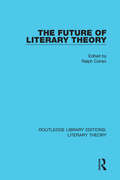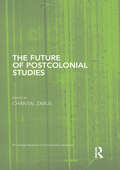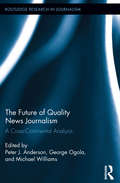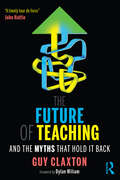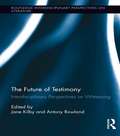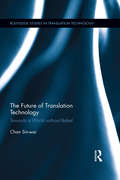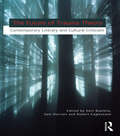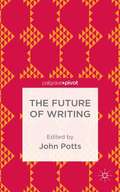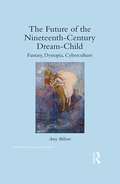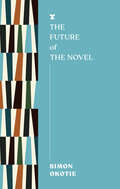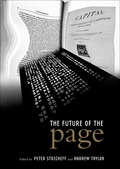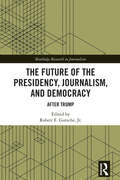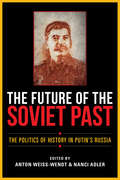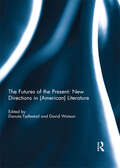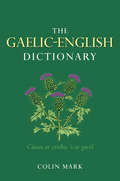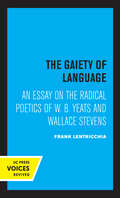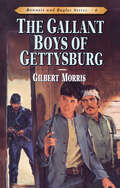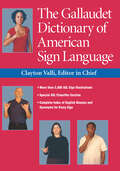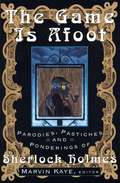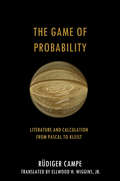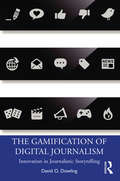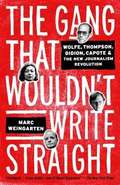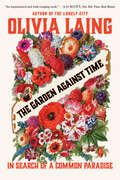- Table View
- List View
The Future of Literary Theory (Routledge Library Editions: Literary Theory)
by Ralph CohenIn this book, first published in 1989, twenty-give eminent critics and theorists write about different aspects of literary theory. These essays represent leading research in psychoanalytic criticism, new historicism, Continental theory, feminism, Afro-American studies, philosophy, cybernetics, aesthetics, and other theoretical inflections. The result is a collective statement on the course that lies ahead for criticism in the humanities, and will be of interest to students of literary theory.
The Future of Postcolonial Studies (Routledge Research in Postcolonial Literatures)
by Chantal ZabusThe Future of Postcolonial Studies celebrates the twenty-fifth anniversary of the publication of The Empire Writes Back by the now famous troika - Bill Ashcroft, Gareth Griffiths and Helen Tiffin. When The Empire Writes Back first appeared in 1989, it put postcolonial cultures and their post-invasion narratives on the map. This vibrant collection of fifteen chapters by both established and emerging scholars taps into this early mapping while merging these concerns with present trends which have been grouped as: comparing, converting, greening, post-queering and utopia. The postcolonial is a centrifugal force that continues to energize globalization, transnational, diaspora, area and queer studies. Spanning the colonial period from the 1860s to the present, The Future of Postcolonial Studies ventures into other postcolonies outside of the Anglophone purview. In reassessing the nation-state, language, race, religion, sexuality, the environment, and the very idea of 'the future,' this volume reasserts the notion that postcolonial is an "anticipatory discourse" and bears testimony to the driving energy and thus the future of postcolonial studies.
The Future of Quality News Journalism: A Cross-Continental Analysis (Routledge Research in Journalism)
by Michael Williams George Ogola Peter J. AndersonIn the face of the continuously changing challenges of the digital age, it is difficult for quality news journalism to survive on any significant scale if a means for adequately funding it is not available. This new study, a follow-up to 2007’s The Future of Journalism in the Advanced Democracies, includes a comparative analysis of possible alternative business models that may save the future of the quality news business across the developed, intermediate, and developing worlds. Its detailed evaluation encompasses also the different ways in which wider key issues are affecting the prospects for quality news as a core ingredient of effectively working democracies. It focuses on the United States, the United Kingdom, South Africa, India, Kenya, and selected parts of the Arab World, providing a comprehensive cross-cultural survey of different approaches to addressing these various issues. To keep the study firmly rooted in the "real world" the contributors include distinguished practitioners as well as experienced academics.
The Future of Teaching: And the Myths That Hold It Back
by Guy ClaxtonIt’s time for the educational slugfest to stop. ‘Traditional’ and ‘progressive’ education are both caricatures, and bashing cartoon images of each other is unprofitable and unedifying. The search for a new model of education – one that is genuinely empowering for all young people – is serious and necessary. Some good progress has already been made, but teachers and school leaders are being held back by specious beliefs, false oppositions and the limited thinking of orthodoxy. Drawing on recent experience in England, North America and Australasia, but applicable round the world, The Future of Teaching clears away this logjam of bad science and slack thinking and frees up the stream of much-needed innovation. This timely book aims to banish arguments based on false claims about the brain and poor understanding of cognitive science, reclaim the nuanced middle ground of teaching that develops both rigorous knowledge and ‘character’, and lay the foundations for a 21st-century education worthy of the name.
The Future of Testimony: Interdisciplinary Perspectives on Witnessing (Routledge Interdisciplinary Perspectives on Literature #28)
by Antony Rowland Jane KilbyCelebrating the twentieth anniversary of the groundbreaking Testimony, this collection brings together the leading academics from a range of scholarly fields to explore the meaning, use, and value of testimony in law and politics, its relationship to other forms of writing like literature and poetry, and its place in society. It visits testimony in relation to a range of critical developments, including the rise of Truth Commissions and the explosion and radical extension of human rights discourse; renewed cultural interest in perpetrators of violence alongside the phenomenal commercial success of victim testimony (in the form of misery memoirs); and the emergence of disciplinary interest in genocide, terror, and other violent atrocities. These issues are necessarily inflected by the question of witnessing violence, pain, and suffering at both the local and global level, across cultures, and in postcolonial contexts. At the volume’s core is an interdisciplinary concern over the current and future nature of witnessing as it plays out through a ‘new’ Europe, post-9/11 US, war-torn Africa, and in countless refugee and detention centers, and as it is worked out by lawyers, journalists, medics, and novelists. The collection draws together an international range of case-studies, including discussion of the former Yugoslavia, Gaza, and Rwanda, and encompasses a cross-disciplinary set of texts, novels, plays, testimonial writing, and hybrid testimonies. The volume situates itself at the cutting-edge of debate and as such brings together the leading thinkers in the field, requiring that each address the future, anticipating and setting the future terms of debate on the importance of testimony.
The Future of Translation Technology: Towards a World without Babel (Routledge Studies in Translation Technology and Techno-Humanities)
by Chan Sin-waiTechnology has revolutionized the field of translation, bringing drastic changes to the way translation is studied and done. To an average user, technology is simply about clicking buttons and storing data. What we need to do is to look beyond a system’s interface to see what is at work and what should be done to make it work more efficiently. This book is both macroscopic and microscopic in approach: macroscopic as it adopts a holistic orientation when outlining the development of translation technology in the last forty years, organizing concepts in a coherent and logical way with a theoretical framework, and predicting what is to come in the years ahead; microscopic as it examines in detail the five stages of technology-oriented translation procedure and the strengths and weaknesses of the free and paid systems available to users. The Future of Translation Technology studies, among other issues: The Development of Translation Technology Major Concepts in Computer-aided Translation Functions in Computer-aided Translation Systems A Theoretical Framework for Computer-Aided Translation Studies The Future of Translation Technology This book is an essential read for scholars and researchers of translational studies and computational linguistics, and a guide to system users and professionals.
The Future of Trauma Theory: Contemporary Literary and Cultural Criticism
by Robert Eaglestone Gert Buelens Sam DurrantThis collection analyses the future of ‘trauma theory’, a major theoretical discourse in contemporary criticism and theory. The chapters advance the current state of the field by exploring new areas, asking new questions and making new connections. Part one, History and Culture, begins by developing trauma theory in its more familiar post-deconstructive mode and explores how these insights might still be productive. It goes on, via a critique of existing positions, to relocate trauma theory in a postcolonial and globalized world, theoretically, aesthetically and materially, and focuses on non-Western accounts and understandings of trauma, memory and suffering. Part two, Politics and Subjectivity, turns explicitly to politics and subjectivity, focussing on the state and the various forms of subjection to which it gives rise, and on human rights, biopolitics and community. Each chapter, in different ways, advocates a movement beyond the sort of texts and concepts that are the usual focus for trauma criticism and moves this dynamic network of ideas forward. With contributions from an international selection of leading critics and thinkers from the US and Europe, this volume will be a key critical intervention in one of the most important areas in contemporary literary criticism and theory.
The Future of Writing
by John PottsThis fascinating collection draws together perspectives on the future of writing in publishing, journalism and online sites. Discussion ranges across the challenges and opportunities for writing and publishing in the context of new content platforms, formats and distribution networks, including e-books, online news and publishing, and social media.
The Future of the Nineteenth-Century Dream-Child: Fantasy, Dystopia, Cyberculture (Children's Literature and Culture)
by Amy BilloneThis book investigates the reappearance of the 19th-century dream-child from the Golden Age of Children's Literature, both in the Harry Potter series and in other works that have reached unprecedented levels of popular success today. Discussing Harry Potter as a reincarnation of Lewis Carroll's Alice and J.M. Barrie's Peter Pan, Billone goes on to examine the recent resurrection of Alice in Tim Burton's Alice, and of Peter Pan in Michael Jackson and in James Bond. Visiting trends that have emerged since the Harry Potter series ended, the book studies revisions of the dream-child in texts and films that have inspired mass fandom in the twenty-first century: Stephenie Meyer's Twilight, E.L. James's 50 Shades of Grey and Suzanne Collins's The Hunger Games. The volume argues that the 21st-century desire to achieve dream-states in relationship to eternal youth results from the way that dreams provide a means of realizing the fantastic yet alarming possibility of escaping from time. This current identification with the dream-child stems from the threat of political unrest and economic and environmental collapse as well as from the simultaneous technophilia and technophobia of a culture immersed in the breathless revolution of the digital age. This book not only explores how the dream-child from the past has returned to reflect misgivings about imagined dystopian futures but also reveals how the rebirth of the dream-child opens up possibilities for new narratives where happy endings remain viable against all odds. It will appeal to scholars in a wide variety of fields including Childhood Studies, Children's/YA Literature, Cinema Studies, Cultural Studies, Cyberculture, Gender Studies, Queer Studies, Gothic Studies, New Media, and Popular Culture.
The Future of the Novel (The FUTURES Series)
by Simon OkotieAuthor and essayist Simon Okotie interprets the signposts – evident through the history of the novel – that point to the form&’s future.We&’re used to the novel being declared dead, dying, or endangered. Seemingly every few years, a critic will read it the last rites – yet the form remains more popular than ever with readers. In The Future of the Novel, author Simon Okotie presents a bold future for long-form fiction, and suggests its evolution is far from over.Okotie begins by responding to and critiquing John Carruthers&’ book Scheherezade, or The Future of the English Novel, published in 1927 as part of the &‘To-day and To-morrow&’ series – the inspiration for our present-day FUTURES. He then cites others who have since meditated on the direction of the form: Henry James, D. H. Lawrence, William Burroughs, Anaïs Nin, Zadie Smith, and China Miéville, among others. In doing so, he also tells the story of the novel itself, from the realism of the 18th and 19th centuries, through the early stirrings of modernism with its focus on the &‘inner life&’, right through to the abstraction and experimentation of 21st century postmodernism, and beyond.All of which informs Okotie&’s own future vision for the novel – one that extends even further into the reaches of the subconscious, and speculates on the uneasy role artifical intelligence will play in the coming decades.The Future of The Novel is a rich and immersive portrait of an artform which, despite constant claims to the contrary, is more alive and exciting than ever.
The Future of the Page
by Andrew Taylor Peter StoicheffThe most basic unit of the physical book is the page. It has determined the historical evolution of the book, the types of information communicated, and how the audience accesses that information.Unique and rewarding in both its scope and approach, The Future of the Page is a collection of essays that presents the best of recent critical theory on the history and future of the page and its enormous influence on Western thought and culture. Spanning the centuries between the earliest record of the page and current computerized conceptions of page-like entities, the essays examine the size of the page, its relative dimensions, materials, design, and display of information.The page is broadly defined, allowing the volume to explore topics ranging from medieval manuscripts to non-European alternatives to the page, Algonquin symbolic literacy, and hypertext. This thought-provoking collection will appeal to literary scholars, book historians, graphic designers, and those interested in the impact of evolving print technologies on intellectual and cultural life.
The Future of the Presidency, Journalism, and Democracy: After Trump (Routledge Research in Journalism)
by Robert E. Gutsche Jr.This volume examines the effects of Donald Trump’s presidency on journalistic practices, rhetoric, and discourses. Rooted in critical theory and cultural studies, it asks what life may be like without Trump, not only for journalism but also for American society more broadly. The book places perspectives and tensions around the Trump presidency in one spot, focusing on the underlying ideological forces in tensions around media trust, Trumpism, and the role of journalism in it all. It explores how journalists dealt with racist rhetoric from the White House, relationships between the Office of the President and social media companies, citizens, and journalists themselves, while questioning whether journalism has learned the right lessons for the future. More importantly, chapters on liberal media "bias," the First 100 Days of the Biden Presidency, gender, and race, and how journalists should adopt measures to "reduce harm" hint as to where politics and journalism may go next. Reshaping the scholarly and public discourse about where we are headed in terms of the presidency and publics, social media, and journalism, this book will be an important resource for scholars and graduate students of journalism, media studies, communication studies, political science, race and ethnic studies and sociology.
The Future of the Soviet Past: The Politics of History in Putin's Russia
by Steven A. Barnes Stephen M. Norris Boris Noordenbos Nikolay Koposov George Soroka Kiril Feferman Johanna Dahlin Štěpán Černoušek Ivan Kurilla Nikita PetrovIn post-Soviet Russia, there is a persistent trend to repress, control, or even co-opt national history. By reshaping memory to suit a politically convenient narrative, Russia has fashioned a good future out of a "bad past." While Putin's regime has acquired nearly complete control over interpretations of the past, The Future of the Soviet Past reveals that Russia's inability to fully rewrite its Soviet history plays an essential part in its current political agenda. Diverse contributors consider the many ways in which public narrative shapes Russian culture—from cinema, television, and music to museums, legislature, and education—as well as how patriotism reflected in these forms of culture implies a casual acceptance of the valorization of Stalin and his role in World War II. The Future of the Soviet Past provides effective and nuanced examples of how Russia has reimagined its Soviet history as well as how that past still influences Russia's policymaking.
The Futures of the Present: New Directions in (American) Literature
by Danuta Fjellestad and David WatsonIt has become a critical commonplace that postmodernism no longer serves as an adequate designation for contemporary literature. But what comes after postmodernism? What are the tendencies and directions within contemporary American literature that promise to shape its future? The contributions to this book are written in the shadows of ‘new media’, a turn towards the nonhuman in critical thinking, and a surge in environmental and apocalyptic thought. Engaging with such contemporary debates, the authors map the rapidly changing ecosystem of contemporary literary genres and forms and attend to transformations in the production, reception, and circulation of books. This book takes for granted that American literature does have a future, although whatever this future holds, it is unlikely to be what we expect. At this historical juncture, the American novel seems to carve its future though an engagement with issues at the forefront of our present, thereby ensuring its own ongoing contemporaneity. This book was originally published as a special issue of Studia Neophilologica.
The Gaelic-English Dictionary
by Colin B.D. MarkThis book fulfils a keenly-felt need for a modern, comprehensive dictionary of Scottish Gaelic into English. The numerous examples of usage and idiom in this work have been modelled on examples culled from modern literature, and encompass many registers ranging from modern colloquial speech, to more elaborate literary constructions. The main contemporary terms and idiomatic phraseology, often not available in other dictionaries, provide excellent models for easier language learning. In addition to the main dictionary, the volume contains introductory material, providing guidance on using the dictionary, spelling and pronunciation. There are also twelve useful appendices which cover not only the various parts of speech, lenition and proper nouns, but also address the more difficult issues of expressing time, direction and numerals. The clarity of the design and layout of the volume will greatly ease the process of attaining mastery of the Gaelic language.
The Gaiety of Language: An Essay on the Radical Poetics of W. B. Yeats and Wallace Stevens (Perspectives in Criticism #19)
by Frank LentricchiaThis title is part of UC Press's Voices Revived program, which commemorates University of California Press’s mission to seek out and cultivate the brightest minds and give them voice, reach, and impact. Drawing on a backlist dating to 1893, Voices Revived makes high-quality, peer-reviewed scholarship accessible once again using print-on-demand technology. This title was originally published in 1968.
The Gallant Boys of Gettysburg (Bonnets and Bugles #6)
by Gilbert MorrisLeah&’s sister Sarah is on her way to that quaint little Pennsylvania town of Gettysburg to help out an old friend. Tom, who is Jeff&’s brother and the soldier Sarah loves, is also headed to Gettysburg, but with the Army of Northern Virginia. Neither of them know that the Northern and Southern troops are about to clash at peaceful little Gettysburg in the bloodiest battle of the Civil War. As Tom fights his way into town, he sees a girl running, threatened by the deadly shells, and is shocked to recognize her as Sarah. Share their fears, their heartbreak. Learn what they learn--that God is with His people even when life gets rough.The Gallant Boys of Gettysburg is the sixth of a ten book series, that tells the story of two close families find themselves on different sides of the Civil War after the fall of Fort Sumter in April 1861. Thirteen year old Leah becomes a helper in the Union army with her father, who hopes to distribute Bibles to the troops. Fourteen year old Jeff becomes a drummer boy in the Confederate Army and struggles with faith while experiencing personal hardship and tragedy. The series follows Leah, Jeff, family, and friends, as they experience hope and God&’s grace through four years of war.
The Gallant Boys of Gettysburg (Bonnets and Bugles #6)
by Gilbert MorrisLeah&’s sister Sarah is on her way to that quaint little Pennsylvania town of Gettysburg to help out an old friend. Tom, who is Jeff&’s brother and the soldier Sarah loves, is also headed to Gettysburg, but with the Army of Northern Virginia. Neither of them know that the Northern and Southern troops are about to clash at peaceful little Gettysburg in the bloodiest battle of the Civil War. As Tom fights his way into town, he sees a girl running, threatened by the deadly shells, and is shocked to recognize her as Sarah. Share their fears, their heartbreak. Learn what they learn--that God is with His people even when life gets rough.The Gallant Boys of Gettysburg is the sixth of a ten book series, that tells the story of two close families find themselves on different sides of the Civil War after the fall of Fort Sumter in April 1861. Thirteen year old Leah becomes a helper in the Union army with her father, who hopes to distribute Bibles to the troops. Fourteen year old Jeff becomes a drummer boy in the Confederate Army and struggles with faith while experiencing personal hardship and tragedy. The series follows Leah, Jeff, family, and friends, as they experience hope and God&’s grace through four years of war.
The Gallant Spaniard
by Miguel de CervantesThere are surprising omissions in the translated body of Spanish Golden Age literature, including in the corpus of Miguel de Cervantes. We have many highly competent translations of Don Quixote, but until now not a single English version of his play The Gallant Spaniard. Although Cervantes&’s dramatic works have always attracted less attention than his narrative fiction, there has been significant critical interest in this play in recent years, due in no small part to its unique portrayal of Christian-Muslim relations. Critics have argued persuasively about the value of The Gallant Spaniard in the service of a more general understanding of Cervantes in his last years, specifically in regard to his views on this cultural divide. This edition, translated by Philip Krummrich, consists of a critical introduction and a full verse translation of the play with notes.
The Gallaudet Dictionary of American Sign Language
by Peggy Swartzel Lott Daniel Renner Rob HillsCreated by an unparalleled board of experts led by renowned ASL linguist and poet Clayton Valli, The Gallaudet Dictionary of American Sign Language contains over 3,000 illustrations. Each sign illustration, including depictions of fingerspelling when appropriate, incorporates a complete list of English synonyms. A full, alphabetized English index enables users to cross-reference words and signs throughout the entire volume. The comprehensive introduction lays the groundwork for learning ASL by explaining in plain language the workings of ASL syntax and structure. It also offers examples of idioms and describes the antecedents of ASL, its place in the Deaf community, and its meaning in Deaf culture. This extraordinary reference also provides a special section on ASL classifiers and their use. Readers will find complete descriptions of the various classifiers and examples of how to use these integral facets of ASL. The Gallaudet Dictionary of American Sign Language is an outstanding ASL reference for all instructors, students, and users of ASL. *Please note that this paperback edition does not include the DVD found in the hardcover edition.
The Game Is Afoot: Parodies, Pastiches and Ponderings of Sherlock Holmes
by Marvin KayeThis long awaited volume finally brings to light several cases of the world's most renowned detective originally suppressed to avoid causing scandal and embarrassment to the Crown, to public figures, or to Sherlock Holmes himself. Now, finally, the truth is revealed about Holmes' exploits involving such figures as Ida Tarbell, Consuelo Vanderbilt, P. G. Wodehouse, and James McNeil Whistler. Related by diverse hands, including Watson, Inspector Lestrade, and Holmes himself, detailing untold incidents involving the Titanic, Holmes' rematch with Irene Adler, the childhoods of both Holmes and Watson, and one unfortunate result of Holmes' facility with disguise, this cornucopia of Sherlockiana will delight fans young and not-so-young.
The Game of Probability: Literature and Calculation from Pascal to Kleist
by Rudiger CampeThere exist literary histories of probability and scientific histories of probability, but it has generally been thought that the two did not meet. Campe begs to differ. Mathematical probability, he argues, took over the role of the old probability of poets, orators, and logicians, albeit in scientific terms. Indeed, mathematical probability would not even have been possible without the other probability, whose roots lay in classical antiquity. The Game of Probabilityrevisits the seventeenth and eighteenth-century "probabilistic revolution," providing a history of the relations between mathematical and rhetorical techniques, between the scientific and the aesthetic. This was a revolution that overthrew the "order of things," notably the way that science and art positioned themselves with respect to reality, and its participants included a wide variety of people from as many walks of life. Campe devotes chapters to them in turn. Focusing on the interpretation of games of chance as the model for probability and on the reinterpretation of aesthetic form as verisimilitude (a critical question for theoreticians of that new literary genre, the novel), the scope alone of Campe's book argues for probability's crucial role in the constitution of modernity.
The Gamification of Digital Journalism: Innovation in Journalistic Storytelling
by David O. DowlingThis book examines the brief yet accelerated evolution of newsgames, a genre that has emerged from puzzles, quizzes, and interactives augmenting digital journalism into full-fledged immersive video games from open-world designs to virtual reality experiences. Critics have raised questions about the credibility and ethics of transforming serious news stories of political consequence into entertainment media, and the risks of trivializing grave and catastrophic events into mere games. Dowling explores both the negatives of newsgames, and how the use of entertainment media forms and their narrative methods mainly associated with fiction can add new and potentially more powerful meaning to news than traditional formats allow. The book also explores how industrial and cultural shifts in the digital publishing industry have enabled newsgames to evolve in a manner that strengthens certain core principles of journalism, particularly advocacy on behalf of marginalized and oppressed groups. Cutting-edge and thoughtful, The Gamification of Digital Journalism is a must-read for scholars, researchers, and practitioners interested in multimedia journalism and immersive storytelling.
The Gang that Wouldn’t Write Straight: Wolfe, Thompson, Didion, and the New Journalism Revolution
by Marc WeingartenIn the 1960s and 1970s, a revolutionary style of journalism emerged in the United States. In this accessible account, Weingarten describes how writers such as Tom Wolfe, Hunter S. Thompson, and Joan Didion discarded the traditional tools of objective reporting in order to immerse themselves in the stories they covered. He also celebrates the leadership of magazine editors such as Harold Hayes and Clay Felker, who helped make the movement possible. Annotation ©2006 Book News, Inc. , Portland, OR (booknews. com)
The Garden Against Time: In Search of a Common Paradise
by Olivia LaingFinalist for the 2024 Kirkus Prize for Nonfiction Finalist for the 2024 Wainwright Prize for Nature Writing A #1 Sunday Times (UK) Bestseller • A New York Times Book Review Editors' Choice • A Kirkus Reviews "Best Book of the 21st Century (So Far)" • A New Yorker Best Book of 2024 • A Chicago Public Library Must-Read Book of 2024 • An Oprah Daily "Most Thought-Provoking Book" of 2024 "An impassioned and wide-ranging work." —A.O. Scott, New York Times Book Review Inspired by the restoration of her own garden, "imaginative and empathetic critic" (NPR) Olivia Laing embarks on an exhilarating investigation of paradise. In 2020, Olivia Laing began to restore an eighteenth-century walled garden in Suffolk, an overgrown Eden of unusual plants. The work brought to light a crucial question for our age: Who gets to live in paradise, and how can we share it while there’s still time? Moving between real and imagined gardens, from Milton’s Paradise Lost to John Clare’s enclosure elegies, from a wartime sanctuary in Italy to a grotesque aristocratic pleasure ground funded by slavery, Laing interrogates the sometimes shocking cost of making paradise on earth. But the story of the garden doesn’t always enact larger patterns of privilege and exclusion. It’s also a place of rebel outposts and communal dreams. From the improbable queer utopia conjured by Derek Jarman on the beach at Dungeness to the fertile vision of a common Eden propagated by William Morris, new modes of living can and have been attempted amidst the flower beds, experiments that could prove vital in the coming era of climate change. The result is a humming, glowing tapestry, a beautiful and exacting account of the abundant pleasures and possibilities of gardens: not as a place to hide from the world but as a site of encounter and discovery, bee-loud and pollen-laden.
